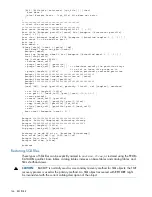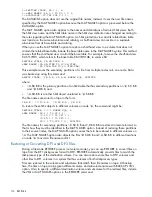
\??.$VOL.SUBVOL
Table1
2.
After running RESTORE with the LISTONLY option once, run it again, but use the
appropriate QFS in RESTORE command along with a MAP NAMES option to specify the
destination node names.
For example, you can restore the files from Step 1 with the command:
RESTORE $TAPE, ( \B.$VOL.SUBVOL.TABLE1 ),&
MAP NAMES ( \B.$VOL.SUBVOL.* TO $NEW.SUB.* )
You cannot restore the files of a remote file set if the system node is offline. RESTORE
cannot resolve the system node number of the remote files.
Qualified File Sets
If you attempt to restore files from a BACKUP tape, you need to remember the file set syntax. A
file set is specified in the form:
[[[ \node.]$volume.]subvolume.]file-id
•
A file set can contain wild-card characters in the volume, subvolume, and file-id fields. A file
set with the asterisk in all three positions (*.*.*) instructs the RESTORE to restore all files on
the tape, including both the local and remote files.
•
A file set with a dollar sign in the volume location ($*.*.*) instructs RESTORE to restore all of
the local files on the tape. Any files stored on tape in the remote node format will not be
restored or listed using this format. For example, if you have a tape with a remote file-set from
\B, the QFS "$*.*.*" will not be restored because the QFS of "$VOL.*.*" designates a file
set that is local to the RESTORE system:
RESTORE $TAPE, ( $*.*.* )
You receive this message:
\A
Files not found - Error 2013
If this situation occurs, use "*.*.*" with an appropriate MAP NAMES option to restore all of
the files to the local node:
RESTORE $TAPE, ( *.*.* ), MAP NAMES ( *.*.* TO $NEW.SUB.* )
\A.$NEW.SUB
Table1
TInd1
You could also use the remote node name for the file-set list (if you know it). Use the node
name in the file set (\ node.$*.*.*) to instruct RESTORE to restore all of the files from that
node:
RESTORE $TAPE, ( \B.$VOL.*.* ),
MAP NAMES ( \B.$VOL.*.* TO $NEW.SUB.* )
\A.$NEW.SUB
Table1
Moving SQL Objects
You can use the MAP NAMES option to move SQL objects to another volume or node. However,
be careful to define the MAP NAMES and CATALOGS parameters correctly for the dependent
tables, indexes, views, and programs. An incorrect or incomplete mapping scheme can leave the
objects invalid or cause the RESTORE process to fail. The MAP NAMES mapping list must be
complete even for recovering an individual partition. Every partition contains a complete list of all
other partitions and must be completely mapped for the SQL object to function.
To restore backup files $A.*.* to a different volume, $C.*.*, and register the files in the catalog
$C.CAT:
RESTORE Guidelines and Examples
173
Содержание BACKCOPY
Страница 113: ...Format of the Permanent Work File 1 13 ...
Страница 114: ...1 14 Disk Space Analysis Program DSAP ...
















































